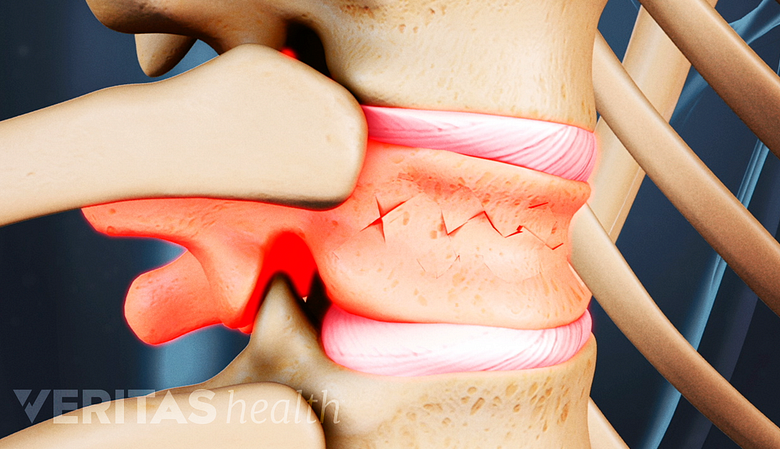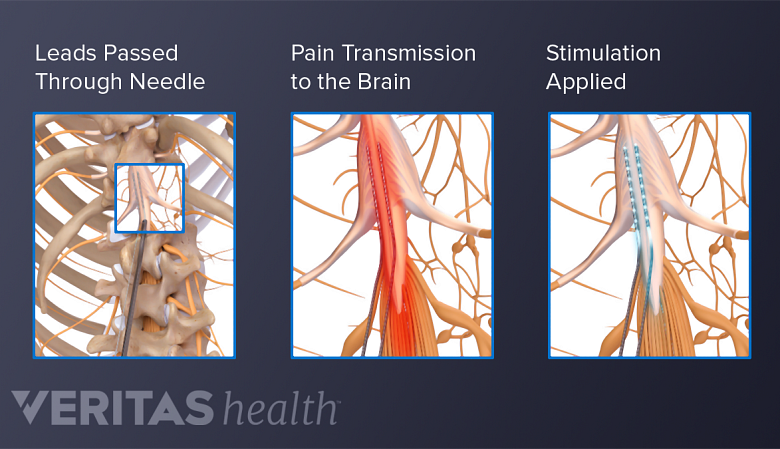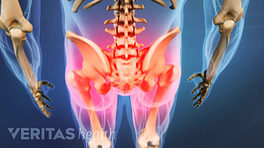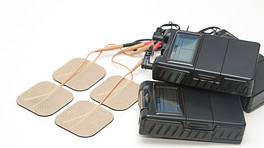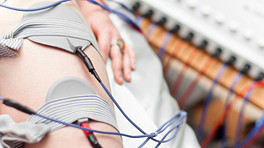Percutaneous neuromodulation therapy (PNT) is the electrical stimulation of a peripheral nerve through several hair-thin needles that are inserted into the skin to reach the muscles supplied by the nerve. This treatment aims to stimulate the nerve with low- to medium-frequency electric current, which in turn stops it from transmitting pain signals from the muscle to the brain. PNT aims to reduce pain and restore function in the affected muscle. 1 Fidalgo-Martin I, Ramos-Álvarez JJ, Murias-Lozano R, Rodríguez-López ES. Effects of percutaneous neuromodulation in neuromusculoskeletal pathologies: A systematic review. Medicine (Baltimore). 2022;101(41):e31016. doi:10.1097/MD.0000000000031016
PNT is combined with other first-line treatments, such as pain-relieving medication and/or physical therapy, and is usually not used as a stand-alone treatment for managing pain.
PNT is minimally invasive and combines the concepts and techniques of transcutaneous electric nerve stimulation (TENS) and acupuncture to provide pain relief through nerve stimulation. PNT may also be referred to as percutaneous electrical nerve stimulation (PENS), electrical dry needling, or intramuscular electrical stimulation. 1 Fidalgo-Martin I, Ramos-Álvarez JJ, Murias-Lozano R, Rodríguez-López ES. Effects of percutaneous neuromodulation in neuromusculoskeletal pathologies: A systematic review. Medicine (Baltimore). 2022;101(41):e31016. doi:10.1097/MD.0000000000031016 While several fine needles are inserted into the skin for this procedure, the treatment is relatively painless, and patients shouldn’t feel any considerable discomfort throughout the process.
In This Article:
- Percutaneous Neuromodulation Therapy (PNT)
- Percutaneous Neuromodulation Therapy for Lower Back Pain
Types of Pain PNT May Treat
Percutaneous neuromodulation therapy may be recommended for the treatment of chronic muscle pain (muscle pain that lasts over 3 months) and nerve pain that is modulated through the central nervous system. 1 Fidalgo-Martin I, Ramos-Álvarez JJ, Murias-Lozano R, Rodríguez-López ES. Effects of percutaneous neuromodulation in neuromusculoskeletal pathologies: A systematic review. Medicine (Baltimore). 2022;101(41):e31016. doi:10.1097/MD.0000000000031016
Prolonged exposure to significant pain can cause changes to the nervous tissue, making the nerves hyperexcitable and the body more sensitive to even slight touch—a phenomenon known as central sensitization. Nerves become hyperexcitable when an episode of pain triggers changes within the nerve cells, resulting in a kind of irritability that persists in the nervous tissue even after the initial injury or trauma has healed. The overly sensitive nerves can continue to create chronic and/or recurring bouts of pain and inflammation even though there is no underlying injury causing the pain. 2 Colloca L, Ludman T, Bouhassira D, et al. Neuropathic pain. Nat Rev Dis Primers. 2017;3:17002. Published 2017 Feb 16. doi:10.1038/nrdp.2017.2
PNT aims to ease central sensitization and calm hyperexcitable and irritable nerves. In doing so, the treatment also intends to improve function in the affected muscle. 1 Fidalgo-Martin I, Ramos-Álvarez JJ, Murias-Lozano R, Rodríguez-López ES. Effects of percutaneous neuromodulation in neuromusculoskeletal pathologies: A systematic review. Medicine (Baltimore). 2022;101(41):e31016. doi:10.1097/MD.0000000000031016 , 2 Colloca L, Ludman T, Bouhassira D, et al. Neuropathic pain. Nat Rev Dis Primers. 2017;3:17002. Published 2017 Feb 16. doi:10.1038/nrdp.2017.2
Goals of Percutaneous Neuromodulation Therapy
Percutaneous neuromodulation eases pain and inflammation using fine needles and low-voltage current.
Percutaneous neuromodulation therapy uses several fine needle electrodes that are inserted at a depth of 2 cm to 5 cm into the skin to reach the muscle and surrounding soft tissues. 1Low-voltage electric current is then passed through these needles, which are hypothesized to 1, 3 , 4 :
- Improve muscle function by altering the pain signals that travel from the painful muscle to the brain
- Improve blood flow to the painful area, fostering healing
- Reduce inflammation and soreness
- Increase muscle endurance, strength, and balance
Several sessions of percutaneous neuromodulation therapy may be needed to manage pain. Each session typically lasts for 30 minutes but may range anywhere from 30 minutes to an hour. The number and duration of sessions depend on the type, cause, and duration of pain. 1
When PNT Is Not Indicated
Percutaneous neuromodulation therapy is not used to treat pain from fractures.
In general, pain due to cancer, an active spinal or general infection (such as osteomyelitis or discitis), fracture, or medical emergencies is not treated with PNT. Additionally, patients who are pregnant or have an implanted pacemaker should not be treated with electrical stimulation to avoid complications to the fetus or malfunction of the pacemaker device.
Potential Side Effects of PNT
The risk of adverse events and side effects is generally low in PNT. Since the needles used in this treatment are hair-thin and the depth of needle insertion is low, damage to soft tissues or nerves is less likely to occur. Some redness may appear at the site of needle insertion, which usually resolves in a few hours without treatment. In rare cases, needle breakage or damage to a blood vessel or nerve may occur if the needle is inserted deeper than the required amount.
A physician or physical therapist trained in the PNT procedure administers this treatment at a doctor’s office, clinic, hospital, or physical therapy center.
Other Types of Electrical Stimulation Similar to PNT
Functional Electrical Stimulation (FES) involves surgically implanting electrodes near painful nerves.
Electrical stimulation treatments that provide similar results as PNT but vary slightly in technique include:
- Functional electrical stimulation (FES). In FES, electrodes are surgically implanted into the body in close proximity to the painful nerves. 5 Marquez-Chin C, Popovic MR. Functional electrical stimulation therapy for restoration of motor function after spinal cord injury and stroke: a review. Biomed Eng Online. 2020;19(1):34. Published 2020 May 24. doi:10.1186/s12938-020-00773-4 FES may be useful for long-term pain management where patients can perform the therapy at their homes with the use of an electrical device. This method may be expensive and may also increase the risk of infection in some individuals.
- Transcutaneous electric nerve stimulation (TENS): In TENS, the electrodes are taped to the patient’s skin and there is no insertion of needles. 5 Marquez-Chin C, Popovic MR. Functional electrical stimulation therapy for restoration of motor function after spinal cord injury and stroke: a review. Biomed Eng Online. 2020;19(1):34. Published 2020 May 24. doi:10.1186/s12938-020-00773-4 TENS may be performed at a physical therapy center, physician’s office, or at the patient’s home.
FES is more closely related to PNT as both these methods target the nerves with closer proximity.
Percutaneous neuromodulation therapy is an emerging treatment in the management of back pain and neck pain. While more research is needed to understand the complete short- and long-term benefits of this treatment, several studies suggest that when combined with first-line treatments, PNT may help reduce pain and improve spinal function. 1 Fidalgo-Martin I, Ramos-Álvarez JJ, Murias-Lozano R, Rodríguez-López ES. Effects of percutaneous neuromodulation in neuromusculoskeletal pathologies: A systematic review. Medicine (Baltimore). 2022;101(41):e31016. doi:10.1097/MD.0000000000031016
- 1 Fidalgo-Martin I, Ramos-Álvarez JJ, Murias-Lozano R, Rodríguez-López ES. Effects of percutaneous neuromodulation in neuromusculoskeletal pathologies: A systematic review. Medicine (Baltimore). 2022;101(41):e31016. doi:10.1097/MD.0000000000031016
- 2 Colloca L, Ludman T, Bouhassira D, et al. Neuropathic pain. Nat Rev Dis Primers. 2017;3:17002. Published 2017 Feb 16. doi:10.1038/nrdp.2017.2
- 5 Marquez-Chin C, Popovic MR. Functional electrical stimulation therapy for restoration of motor function after spinal cord injury and stroke: a review. Biomed Eng Online. 2020;19(1):34. Published 2020 May 24. doi:10.1186/s12938-020-00773-4
